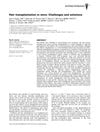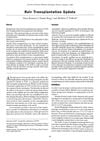TLDR Cooling hair micrografts during transplantation does not improve their survival or growth.
In the 1999 study involving 240 anagen hair follicles from 10 male patients, researchers found that cooling hair micrografts to 1°C did not significantly affect their survival or growth rates compared to those stored at room temperature (26°C). After a 5-hour storage period and 10 days of culturing, the survival rates were 87% for the control group and 88% for the experimental group, with mean growth rates of 2.68 mm and 2.54 mm, respectively. The study concluded that cooling does not enhance the outcomes of hair micrografts in transplantation surgery.
 10 citations
,
January 1997 in “Scandinavian journal of plastic and reconstructive surgery and hand surgery”
10 citations
,
January 1997 in “Scandinavian journal of plastic and reconstructive surgery and hand surgery” A new technique using a multibladed knife makes preparing hair transplant minigrafts faster and more uniform, leading to natural-looking results.
20 citations
,
February 1994 in “In vitro cellular & developmental biology. Animal” Wool follicles can grow in a lab with the right nutrients and conditions.
385 citations
,
November 1990 in “Journal of Cell Science” Human hair follicles can grow in a lab setting.
 3 citations
,
April 2016 in “Wound Repair and Regeneration”
3 citations
,
April 2016 in “Wound Repair and Regeneration” Researchers successfully transplanted hair follicles in mice, which survived well and helped in wound healing.
 8 citations
,
January 1998 in “Journal of Cutaneous Medicine and Surgery”
8 citations
,
January 1998 in “Journal of Cutaneous Medicine and Surgery” Hair transplantation is effective for baldness, with new methods improving results, but staying updated is crucial for patient outcomes.
15 citations
,
December 1994 in “The American Journal of Cosmetic Surgery” Half follicular grafts are not effective for hair transplants.



